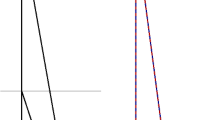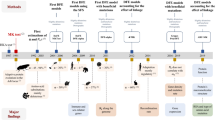Summary
It is suggested that in evolution there is much substitution of nearly neutral mutations, for which the selection intensity varies from time to time or from region to region. Since the variance among the selection coefficients of new mutants decreases when the environment becomes uniform, the probability of a mutant being advantageous to the species as a whole increases in more uniform environment (Fig. 1).
Therefore the rate of gene substitution increases in smaller populations, as smaller populations are likely to be distributed over less varied environments.
The adequacy of the model was discussed in relation with the following facts or plausible postulates. 1. A large number of amino acid substitutions during a period corresponding to the formation of new species. 2. Rapid evolution at the phenotypic level of populations having a small size. 3. Many extinctions and expansions of the species in the past.
Similar content being viewed by others
References
Crow, J. F.: Proc. 6th Berkeley Symp. Mathematical Statistics and Probability (in press) (1972).
Fisher, R. A.: The genetical theory of natural selection. Oxford: Clarendon Press 1930.
Fitch, W. M., Markowitz, E.: Biochem. Genet.4, 579–593 (1970).
Haldane, J. B. S.: The causes of evolution. New York: Cornell Univ. Press 1932.
Haldane, J. B. S.: J. Genet.55, 511–524 (1957).
Kimura, M.: Ann. Math. Stat.28, 882–901 (1957).
Kimura, M.: Genetics47, 713–719 (1962).
King, J. L., Jukes, T. H.: Science164, 788–798 (1969).
Margoliash, E., Barlow, G. H., Byers, V.: Nature (Lond.)288, 723–726 (1970).
Mayr, E.: Animal species and evolution. Cambridge: The Belknap Press of Harvard Univ. Press 1963.
Ohno, S.: Evolution by gene duplication. Berlin-Heidelberg-New York: Springer 1970.
Ohta, T.: Genet. Res.19, 33–38 (1972a).
Ohta, T.: J. molec. Evolution1, 150–157 (1972b).
Ohta, T., Kimura, M.: Nature (Lond.)233, 118–119 (1971).
Simpson, G. G.: Tempo and mode in evolution. New York: Columbia Univ. Press 1944.
Uzzell, T., Corbin, K. W.: Science172, 1089–1096 (1971).
Wright, S.: Anat. Rec.44, 287 (1929).
Wright, S.: Genetics16, 97–159 (1931).
Wright, S.: J. Genet.30, 257–266 (1935).
Wright, S.: Amer. Naturalist74, 232–248 (1940).
Wright, S.: Genetics28, 114–138 (1943).
Wright, S.: Evolution2, 279–294 (1948).
Wright, S.: Amer. Naturalist90, 5–24 (1956).
Author information
Authors and Affiliations
Additional information
Contribution No. 871 from the National Institute of Genetics, Mishima, Shizuokaken 411 Japan.
Rights and permissions
About this article
Cite this article
Ohta, T. Population size and rate of evolution. J Mol Evol 1, 305–314 (1972). https://doi.org/10.1007/BF01653959
Received:
Revised:
Issue Date:
DOI: https://doi.org/10.1007/BF01653959




